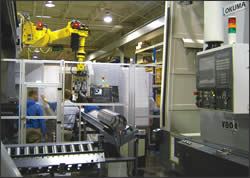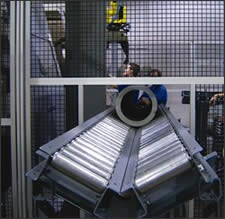Oil Drill Coupling Production Gets Automated
Sponsored by Okuma. A manufacturing cell combines lathes, gantry robot and conveyor system to enable automated production of oil drill couplings.
The oil and energy business continues to grow. To reach deep oil reserves, drilling companies use a series of 40-foot lengths of pipe connected by couplings. The ID, OD and threads of those machined couplings must be accurate so that the pipes don’t leak. Pipe leakage is especially problematic at significant depths.
Manufacturing couplings has traditionally been a manual process. Large companies that make couplings do so by manually loading pipe into older types of machining equipment. The heavy couplings are difficult to for operators to load and chip control during turning and threading operations is challenging.
Until recently, no one had developed an automated system dedicated to manufacturing couplings. Gayle Vollmer, Okuma director of technical resources, suggests the reason is because oil coupling producers are running at full capacity with their existing equipment and have little time for process development. “There’s also a substantial cost factor in putting together a production cell for research and development,” Mr. Vollmer says. “Partners in THINC has not only the products and cell design expertise, but also experience helping shops that serve the oil industry.”
In fact, Okuma and the Partners in THINC have created an automated coupling production cell that is scheduled to be available in August 2007.
Coupling Production Challenges
The oil industry uses two primary types of couplings: “API” couplings for relatively shallow oil wells and “premium” couplings for deep wells (used mostly for off-shore drilling). Demand for premium couplings has dramatically increased. After much research, Partners in THINC decided the time was right to develop a cell that offered a completely automated coupling production process to help meet that demand.
The cell was built and tested at the Partners in THINC facility in Charlotte, North Carolina. After experimenting with various tools, coolants, coolant pressures and machining practices, the Partners were able to solve the primary problem of chip accumulation during the turning and threading operations.
The automated manufacturing process begins with a FANUC overhead gantry robot that loads a double-length coupling blank in and out of the machines. This eliminates the need to have operators lift the heavy 9-5/8-inch-diameter workpieces. The gantry design also offers increased flexibility while saving valuable floor space. During machining, the blank is cut in half, eliminating a secondary sawing operation.
Using Kennametal, a Partners in THINC tooling partner, the roughing and finishing operations for coupling ID and OD are performed on a four-axis Okuma LOC-650 oil-country lathe. This lathe also performs the cutoff operation that separates the blank into two 10-inch-long coupling pieces. The pieces then move down a conveyor to an Okuma V80R vertical turning lathe (VTL). The vertical spindle orientation assists in evacuating chips during turning and threading operations. Both machines are fitted with a Schunk “oil country” chuck.
The chips produced during threading operations fall and flow away from the workpiece thanks to the V80R VTL’s modified tooling adapter and ChipBLASTER high-pressure, high-volume coolant system. Coolant flow from precisely directed nozzles helps break up the chips and flush them out of the machine. After the threading operation, the workpiece is conveyed out of the cell and delivered to a measuring station, where a Marposs gage inspects its threads and diameters. The cycle time to turn, thread and deliver a completed coupling out of the cell is only 11 minutes.
This cellular production method allows complete OD turning in one operation. This helps meet high-precision threading requirements by avoiding the undesirable blend line that occurs with a two-part operation. In addition to increasing production speed, the cell eliminates the need for a 2-minute sawing operation.
Considering the increase in oil drilling activity, this timely Partners in THINC solution for automated production of drill couplings will have far-reaching effects in the oil industry.
Related Content
Choosing Your Carbide Grade: A Guide
Without an international standard for designating carbide grades or application ranges, users must rely on relative judgments and background knowledge for success.
Read More10 Tips for Titanium
Simple process considerations can increase your productivity in milling titanium alloys.
Read MoreThreading On A Lathe
The right choices in tooling and technique can optimize the thread turning process.
Read MoreAll-Around Mill Improves Productivity and Cost for Valve Job
Adopting a mill with a double-negative rake and pockets compatible with multiple insert geometries enabled Progressive Metal Service to increase feed and lower scrap rates for a valve.
Read MoreRead Next
The Cut Scene: The Finer Details of Large-Format Machining
Small details and features can have an outsized impact on large parts, such as Barbco’s collapsible utility drill head.
Read More3 Mistakes That Cause CNC Programs to Fail
Despite enhancements to manufacturing technology, there are still issues today that can cause programs to fail. These failures can cause lost time, scrapped parts, damaged machines and even injured operators.
Read More
















.png;maxWidth=300;quality=90)










